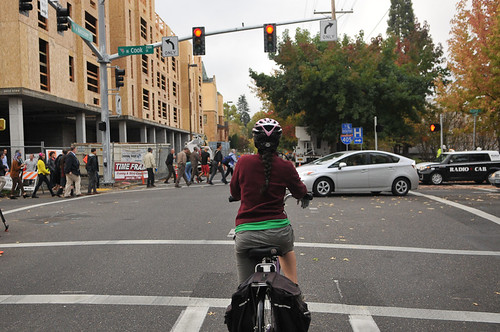
(Photos © J. Maus/BikePortland)
Golden scissors, a red ribbon, coffee and pastries, television cameras and a large crowd that included Bureau of Transportation staff, business owners and neighborhood advocates.
From the looks of this morning’s event at the intersection of North Vancouver and Cook you’d think the city was celebrating the completion of a major project or milestone.

But all this pomp and circumstance was just for a new traffic signal.
Yes, Portland’s wonk-o-meter turned up way past 11 this morning as PBOT Director Leah Treat cut the ribbon and real estate developer Ben Kaiser (sort of sheepishly) flipped a switch to turn on the new signal.
While there was snickering about how the event could have easily passed for a Portlandia episode, there are actually real reasons why this particular new signal warranted such attention.
Vancouver Ave has more daily bike traffic than another other street in city
According to PBOT’s latest bike counts, Vancouver Avenue carries more daily bicycle trips than any other street in the city. Over the past three years an average of 5,000 people on bikes use it every day, making Vancouver the second busiest bikeway overall (behind only the Hawthorne Bridge at 8,000 daily trips).
Vancouver and Cook is a very dangerous intersection
With a freeway offramp that spills into a very busy street that’s adjacent to a grocery store, dense residential development, a hospital and a Red Cross location, this intersection has been a mess for years. With no signal, it was a free-for-all and many people who drive through it demonstrate no regard for the painted crosswalk or the presence of others. PBOT data shows it’s one of the top ten locations for right-hook collisions.
Erik Olson walks across it each morning on his way to work. “Oh good!” he said when I told him what the event was about this morning. “It’s been a challenge to walk to work, there are just too many cars and it’s unregulated,” he addded. “On my way home [northbound] I’ve had to weave between cars just to get across.”
Advertisement
It was paid for by local businesses
“PBOT couldn’t have done this with our own money.”
— Leah Treat, PBOT Director
Calling it a “perfect confluence of interests” PBOT Director Leah Treat wanted everyone to know that this is the first-ever traffic signal in Portland’s history paid for by private businesses through a Local Improvement District (LID). Five local businesses — New Seasons, The Kaiser Group, Owen Gabbert LLC, Legacy Health and the American Red Cross — all chipped to raise over $1 million through the North Vancouver Avenue and Cook Street LID that funded this signal and two others in the area (one at Vancouver and Fremont and another at Cook and Williams)
“PBOT couldn’t have done this with our own money,” Treat said this morning. Andrew Aebi, PBOT’s LID project manager said LIDs are usually formed for things like paving a unpaved road or larger project. Getting businesses to pay for signals “Took a lot of arm-wrestling.”
While these businesses appreciate the safety and livability impact of this signal, their investment wasn’t simply an example of altruism. One of Kaiser’s nearby projects triggered a zoning code change and PBOT mandated the LID as part of signing off on it.
A reaction to rapid pace of nearby development
At the Vancouver/Cook intersection alone there are about 340 new housing units being built. The corridor where this new signal was installed is one of the most rapidly developing areas in the city. These new housing and retail units will add even more traffic volume to nearby streets.
PBOT Director Leah Treat said this morning that as the pace of development increases, “Our responsibility to care for people traveling through this area has increased.” “As a neighborhood develops like this,” she added, “There is mutual interest to do this type of improvement for safety and livability.”
Along with the signal, PBOT is prepping for other changes to the bikeway. By early 2016, they’re planning to restripe the bikeway between Fremont and Cook by adding green “conflict zone” coloration and possibly other changes.
The neighborhood has waited over 40 years for this signal
People who live in the Boise-Eliot neighborhood have been asking for a signal in this location since the Fremont Bridge was built in 1973. Yes you read that right: They’ve waited over 40 years for a safer intersection.
Over the past four decades PBOT has said “we don’t have the money.” But as neighborhood voices rose to power during the city’s North Williams Traffic Safety project back in 2012, it became clear that excuses about funding would no longer suffice.
— Jonathan Maus
jonathan@bikeportland.org
(503) 706-8804
@BikePortland



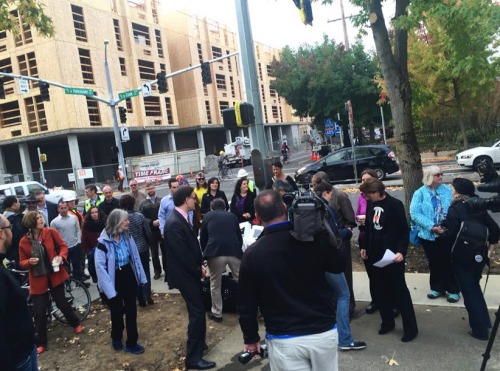
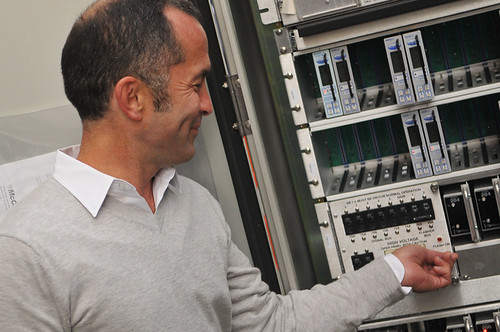
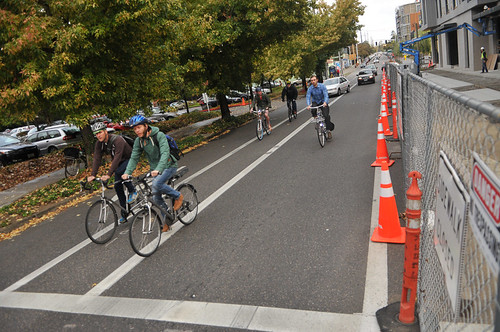
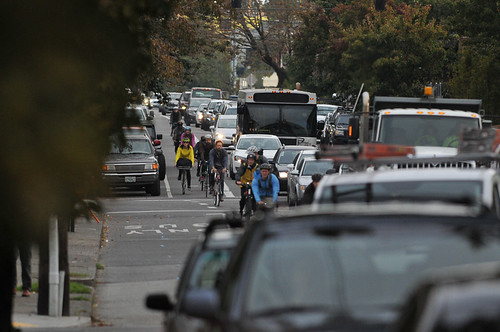
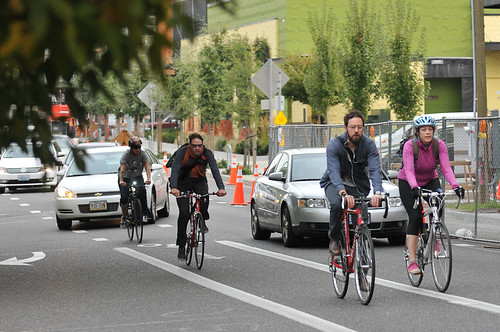
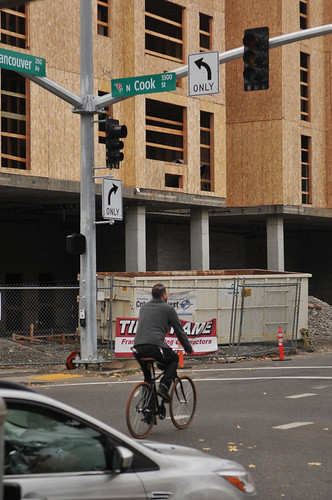
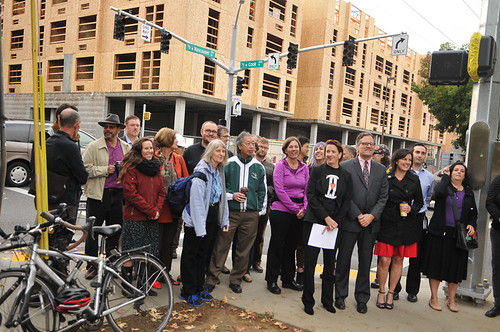
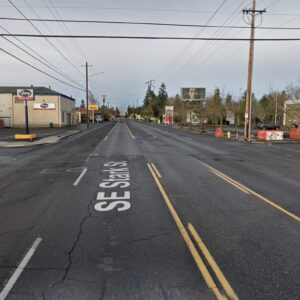
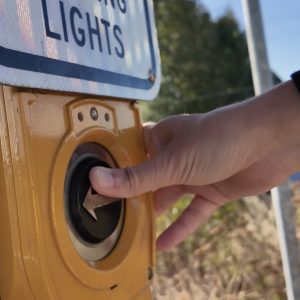
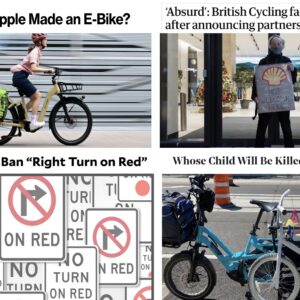
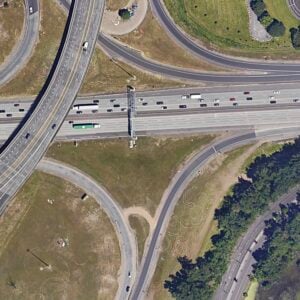
Thanks for reading.
BikePortland has served this community with independent community journalism since 2005. We rely on subscriptions from readers like you to survive. Your financial support is vital in keeping this valuable resource alive and well.
Please subscribe today to strengthen and expand our work.
I moved up to Shaver and Mallory in 99/00 and rode into downtown to work. Even back then when traffic up here was a whole lot lighter this intersection sucked. This has been a long time coming and I’m totally stoked something has finally happened.
And yet another cheapo apartment building being thrown up.
I was just going to comment on that. Anyway, good thing we don’t have tornadoes or hurricanes ’round here. Of course there’s always “the big one” to think about.
Those newly built apartments are likely to fare much better in an earthquake than most of Portland’s housing stock.
Wood-frame buildings actually fare decently well in earthquakes. Especially compared to unreinforced masonry death traps.
Yeah, damn that new housing. How dare people have a place to live! Where’s my torch and pitchfork!
It was much preferable when it was a weed-covered vacant lot!
This is yet another example of the positive influence of the increase in cyclists in the neighborhood. I know the older residents see it as gentrification, but if gentrification makes the neighborhood better what’s the problem?
I am pretty sure the new signal is intended to assist in moving the increased car traffic. As everyone has suggested, this intersection has been very poor for cyclists for a long time. It was not until the increased development and increased car traffic did the problem get resolved.
“if gentrification makes the neighborhood better what’s the problem?”
I think the problem with gentrification is that as the neighborhood gets “better”, people who lived there can no longer afford to.
A bunch of the people who used to live in the neighborhood were anti-bike (this site covered them a few years back), I won’t be crying any tears of those folks can’t afford to live there any more.
Anti-bike? Or incredibly frustrated that their city tore apart their vibrant neighborhood for I5, the Rose Quarter, and Emmanuel Hospital? Anti-bike? Or angry that it took gentrification and a growing population of white people for their neighborhood to get desperately need infrastructure upgrades?
Please don’t be hostile to my neighbors. They are good people who the city treated terribly for decades.
I don’t have anything personal against your neighbors, but you have to admit they were singing the song we’ve heard over and over forever now: “Don’t take away my car parking! Don’t take away our car lanes!” Cars destroy the environment in so many ways, if they’re standing in the way of a just and livable city then I hope they get driven somewhere else.
That’s not what I heard them saying. I didn’t hear the voice of privilege. I heard the anger of people whose requests for improved safety measures had been ignored for years.
thanks, daisy. we had to work pretty hard at the time to counter this kind of commentary on these boards, but after a couple of years the revisionists may feel they have a clear field.
Then why the heck did they fight so hard against the N Williams project’s safety features?????????????????
–
My take on that whole brouhaha was that the city was damned if it did, and damned if it didn’t. The city was criticized for not making the neighborhood safe. Then the city was criticized for trying to make the neighborhood safe. . . because it might make the neighborhood nice enough to attract outsiders to move in. The city finally tries to make a neighborhood more livable and *that’s* when the residents get up in arms?
Be it Portlandia-esque, this was a really exciting moment! Thanks for the coverage! I hope everyone feels a little safer at this intersection now, I know my family will.
This is great, but
…40 years … and in the end privately funded!
And the CRC, which no one needed, cost how many hundreds of millions just to *not* build?
“It will be a great day when our schools get all the money they need and the air force has to hold a bake sale to buy a bomber.”
We need the CRC. We needed it years ago and we need it more-so today.
You might live in a part of town that does not deal with the overflow congestion daily, but my commute is impacted. My neighborhood is impacted.
You’re assuming/asserting that the CRC would have self-evidently helped with the congestion problem you’re experiencing,
We need a seismically improved I-5 bridge. The CRC would have just moved congestion south a couple of miles while permanently closing (and buying out) 3 manufacturers east of the bridge. The bridge was too wide, too low, too impactful to the adjacent neighborhoods and too expensive.
The supposed closure of the manufacturing facilities was far overstated. One of them had never sent an item downstream that would require greater clearance. The other two would send at most one large object downstream every couple years. What’s more the few large objects represented a tiny part of their business. Agricultural shipments are far more important to the economy.
The CRC would make your neighborhood traffic worse. I’m assuming you live near I-5 in N Portland. The CRC would have just moved the bottleneck from the bridge to the 3-lane wide section of I-5 in N Portland. There would be MORE people cutting through neighborhoods, because they know that once they hit the bridge, it’s clear sailing.
The problem that the CRC aimed to fix hasn’t gone away, but the CRC was not the best solution. What we need is another Tilikum Crossing across the Columbia.
And we could have built one with the money they spent designing the failed CRC!
Definitely don’t need the CRC. It was supposed to be paid for by Oregon Taxpayers with federal help for the convenience of Intel Management commuting from Hillsboro to get away from Property/income taxes. Living in Vancouver but with mail drops in Oregon so they can take their kids to school in Oregon.
This is classic begging the question.
You want a solution to the problems in your neighborhood, and somehow the CRC gets a pass as that solution.
The question that needs to be addressed here is: “Is the CRC the solution to the problems?”
It’s not. It was a massive highway project that would have increased traffic capacity and encouraged even more unsustainable car commuting from Vancouver (build it and they will drive even more). Your traffic would have gotten worse. And as someone who used to live RIGHT next to I5, I can say that the last thing we need is more traffic on I5.
As is said below, we need something more along the lines of another Tilikum Crossing.
Why was the Fremont Bridge not built with a pedestrian path?
I don’t think they had pedestrians back in 1973
Interesting question. When were pedestrian and multi-use paths made a requirement for bridges along the interstate system? The 205 bridge (designed in the late 70s) has one, but the Marquam (mid 60s) and Fremont (late 60s) do not have them. Does anyone have a reference for when the design rules changed to include footpaths?
The new, 2014 I-5 bridge over the Willamette River in Eugene doesn’t have a multi-use path.
That’s bridges, not bridge. They built six bridges to replace one at a cost of well over a hundred million dollars (obviously, several of the bridges were “temporary” as only two of them remain). It still gets my goat that the reason for this insane expenditure was supposedly because the original bridge would have had to have its weight limit reduced to 80,000 pounds, which about 46 states somehow manage to live with.
For cars and trucks, there is no cost too high. For human-scale transportation like bikes, pedestrians and trains, well, you know…
I think the new bridges (and those north of Albany) were also built to the latest earthquake standards and to accommodate the eventual widening of I-5 to 3 lanes. Of course, if ODOT would spend more on Amtrak Cascades to Eugene (providing more than just 2 trains per day, and improving speeds) we could get more people off of the road and even run special day trains for sporting events and holidays (the only times this stretch ever gets congested).
“PBOT couldn’t have done this with our own money,”
Really!? the largest city in Oregon can’t buy a traffic signal?
You are correct. The signals going up on Couch at Broadway and in the pearl are funded by pdc. The city is going into debt to finance those traffic signals.
With beg buttons even! At one of the busiest pedestrian intersections in the city! Ugh.
The buttons at Broadway & Couch are for sight-impaired people to trigger audible warnings. They are not beg buttons, since the signal will be pre-timed and coordinated with the other signals along Broadway. Most signals nowadays are put in with these audible-warning buttons whether or not the signals are pre-timed.
Maybe the Head of PDOT should be an elected position…?
I can’t help but wonder about all of those harddrives in the control box… this can’t be the most complicated intersection with it’s 1.5 directions. Why does it need this much computing power? Pete Koonce?
https://www.flickr.com/photos/bikeportland/22156906542
Technically, there probably isn’t a hard drive in there but rather embedded computers with Compact Flash (or some other non-volatile storage media). They’re typically redundant to be fail-safe (if one fails the other takes over so signaling isn’t interrupted), and there may be communications cards networked into a control center to monitor status (these days there may even be network security hardware in there), including possibly wireless access for local maintenance. Much of the bigger stuff you see I suspect is power conditioning.
Glad to see it happened, but concerned that the neighborhood waited 40 years for a traffic light to improve safety. Is PBOT so seriously underfunded that it takes this long and this many interests to come together to produce a signaled intersection?
Short answer yes, long answer is more complicated and involves talking about streetcars. Either way, what’s done is done, and we need a local gas tax if we want safety improvements.
The original development plan by Legacy proposed a roundabout solution.
The issue with the signal is not that it takes one to solve the problem, but that it takes two. People have complained for years about the queue back from the all-way stop onto the freeway off-ramp. But if you eliminate the all-way stop, the queue moves to Vancouver/Cook. So if you eliminate the stops at Vancouver, the queue moves to Williams/Cook. And if you remove the stops at Williams, then the queue moves to Fremont/Williams. The solution is not just one signal, but two new signals and coordination with the third one downstream.
Close sets of signals, usually called boxes, are tricky to time. Consider the Broadway/Weidler/Vancouver/Williams box. The introduction of two parallel two-way streets that cross two parallel one way streets is very difficult to program.
Cars. Ugh.
Congrats! on this project. It shows the redevelopment/ investment power of the bike mode along historic trolley routes.
It would make for an interesting PSU student report to compare the CBA of the public investment in transportation facilities here vs. the NoPo section of the Yellow Line. (Dollar for Dollar the bike investments most likely have the better return multiplier than fixed rail/ or BRT, I would hazard a guess.)
And any other interesting information about this project:
– any special bike friendly phasing or hardware?
– why does PBoT still use above ground signal cabinets in urban intersections with constrained space / sight lines?
If Vancouver Av is such a busy bike street, it should get protected bike lanes. Full stop.
And we will get it, guaranteed.
By 2055, at the very latest.
The signal like this costs a million dollars? Dang!
That’s the price for the pair of signals at Williams and Vancouver at cook. $500k each, which sounds about right.
This is a great and welcome addition. I have certainly swerved out of the bike lane because a car coming off I5 will stop past the crosswalk, and I’ve been in a car trying to get across Vancouver, too, which is plenty stressful in its own right. I imagine this will be much better for everyone, thanks PBOT & businesses who helped fund!
$1 Million for a single traffic signal? Wow. I guess I’m in the wrong business (I should be selling overpriced control hardware to city governments). I guess the next one the city puts in will have to be crowd-funded, or perhaps rented on a 30 year lease from Lockheed Martin.
I think that’s the cost for signals at three intersections. Even so, it seems absurdly expensive.
Yes, I thought I read that right…
This type of equipment is expensive, but it doesn’t really have that big of a markup, believe it or not. As I mentioned above, there’s redundancy, power conditioning, and it even looks like spares sitting in the bottom of the rack (for quick replacement in failure) – all of this at industrial grades, having to survive being on 100% of the time, during the coldest winter months as well as summer heat waves. The copper (and possibly gold) alone in it is fairly expensive (so you can see why they have to secure it so well from theft).
I suspect the budget also includes installation and long-term service contracts, as well as the engineering and traffic studies (timing cycles, etc.) that go along with the projects. (Yes, there may also be some “high-paid consultants” that I often see remarked about in comments on this site, but they’re typically hired for short periods sporadically and don’t carry the pensions of full-time employees – also, the engineering consultants I’ve met don’t actually make that much).
It does make you wonder when we do this only for lack of crosswalk compliance, what if we instead provided every citizen with a red light on a stick and a lifetime supply of batteries? Are we really spending nearly $1 per capita on every traffic signal? We really should hang a camera on it at least until red light fines pay off the initial cost.
Yes, or HIDs with ‘beg buttons’, yellow flags in buckets on either side of crosswalks (should we just make them white? ;)… I still wonder what would happen to the pedestrian kill rate if we (even temporarily) stopped allowing right turns on red lights.
Sigh, the red light camera dilemma… this is happening in lots of places:
http://www.smdailyjournal.com/articles/lnews/2014-09-10/red-light-cameras-shut-down-south-city-takes-down-devices-four-years-after-controversy-over-administrative-errors/1776425129840.html
people have died at one or both of the intersections just signalized.
It’s hard to imagine the entrance to the Fremont Bridge would have ever been added to a white neighborhood in Portland 40 years ago — and certainly not without a signal. It’s a sad thing it took so many years — and likely so much gentrification — for safety to become important enough in this neighborhood (which is my neighborhood).
Many kids who attend Boise-Eliot/Humboldt, a historically African-American neighborhood school, cross through this intersection if they walk or bike to school (and I suspect many parents who live east of Vancouver don’t let their kids walk to school because of this intersection). This signal is welcome, even though it’s many years too late.
I’ll have to check this out.
If I’m reading correctly, though, did they not fix the right turn conflict? I’m thinking that could have been an easy fix, given that they’re installing something that can direct traffic. Wouldn’t it be wise to time separate cars and bikes by having distinct signals for each?
So that excuses the guys who attacked cyclist commuting on Williams?
No, of course not. Are you suggesting that my 60-year-old African American neighbors–you know, the folks most frustrated by the situation–are the ones throwing rocks at cyclists?
Who even remotely suggested that?
Hopefully, Portland traffic division can do some enforcement here. It is like playing frogger crossing the crosswalk by New season with my little kids.
Many years ago, N. Williams had a streetcar line and a vibrant commercial district. It was a 20-minute neighborhood before that was a thing. The city ruined that — it took houses out of a neighborhood that was the only place where African Americans could live. The city leaders made decisions to rip through this vibrant neighborhood.
The anger was not coming from a place a privilege. Rather, it was coming from a place of frustration that the city never cared about this neighborhood until white people moved in. I’m white, and I totally get this anger.
I bike commute daily, and I wanted the Williams improvements as much as any cyclists. But I also took the time to understand my neighbors’ frustration, and I learned a whole lot about Portland’s racist past.
comment of the week
I shouldn’t have to sacrifice my safety on the road so that I could learn about historic injustices perpetrated by people who are not me. There’s no sense in keeping the neighborhood unsafe because of people’s hurt feelings, no matter how justified those feelings. Black bodies matter, and the best way to protect those bodies is to make those streets safer.
people who are not me. perfect. maybe this should be comment of the week instead.
when PBoT and alta first came to the table it was all about bus/bike interactions, nothing about pedestrian crossings, and certainly nothing about the long unmet needs of existing residents.
there was an effort to link the conversation to affordable housing, but that got no traction because the city pretends it can isolate these various concerns into separate silos.
Thanks for holding the line on this throughout these comments, Daisy.
Sure there was resistance to many of these changes, but I saw it as an expression of frustration that had been ignored for years. Finally the city said, “Hey, what do you think about this?” and people who had been sidelined (and redlined!) for years finally had their chance to be heard. I didn’t agree with what a lot of folks were saying, but I got the emotion. Bike improvements were seen as another change (for newcomers) being rammed through without neighborhood input. Give people a chance to be heard even if you don’t like what they have to say. Often what they really want is just to have a chance to say it.
So, should we have left the neighborhood unsafe for people riding bikes?
what made it unsafe for cyclists was a door zone bike lane and a bunch of people who do not know how to pass a bus on the left. neither of these concerns required a complete overhaul, and i have seen plenty of commentary on these boards saying the left side bike lane has not made the situation better.
i will look forward to this perhaps putting a damper on the complete cluster-you-know-what this section of n vancouver between fremont and cook is during the morning commute. one of the highest concentrations of deathwish-based cyclist behavior in the entire city. what i wouldnt give to have everyone i ride in with in the morning just take those few blocks nice and easy, no passing, no sprinting, just nice and easy, single file til everyones past cook – maybe even with *some* awareness that there are cars trying to get over into a freeway entrance, and that theyre mostly being pretty damn polite about it. watching my fellow cyclists desperately try to get themselves killed in that stretch is the low point of my morning.
I’m assuming the light sensors work for cyclists without having to make a bunch of crazy maneuvers to find the sweet spot on a loop?
If they are video-based, that may explain part of the high costs I was referring to (above) in the system. In Santa Clara we replaced about 40 of our cameras with updated versions last year, and although it wasn’t cheap, I’m told they are much more effective at detecting cyclists and pedestrians, especially on dark, rainy days or bright sunny days.
Who’s being the revisionist? Here are quotes from long-time residents on the proposed changes to Williams:
“If a business is looking for a high volume of customers, than how’s that going to happen if it’s just all bicyclists?… What if you want people to be able to get there and their mode of transportation is not a bicycle?… How do those people get to your business if the street is not inviting to them? If there’s no parking, where’s the parking for these businesses? ”
“This is all different…. Change is hard. It works just fine for me.”
Some people might have had different motivations, but there was definitely an anti-bike sentiment at some is those meetings. Given the carnage caused in our community by cars every day you just can’t defend that sort of attitude.
For a street thatnis busy with bikes, why is the bike lane on the wrong side if the parked cars?
So I went through this intersection tonight and was unpleasantly surprised. When I pulled up, there was a truck with outrigged tires on the left and another large truck on the right. Both were encroaching so far into the bike lane that my handlebars nearly touched both of their mirrors.
Heads up:
There is a traffic signal going in at NW 23rd & NW Raleigh.
It wasn’t on as of last week, but I’ll ride by today and see if it’s up & running.
I think it’s is part of the Conway Master plan, if I remember right.
Glad to see these going in.
I’m surprised to read no mention of System Development Charges related to the new construction at this spot. Do SDCs not get used for signal installation or improvements?
That SDC money is already spoken for and tied to projects in other neighborhoods, such as streetcar.
Yes, I recall reading that SDCs aren’t tied to the location from which they’re collected, but instead go into a general pot, which to me seems semi-wrong.
SDCs can only be used for the projects on the adopted SDC project list, which was last adopted in 2007. It will be updated sometime before 2017.
I thought the rule of thumb was $250,000 for a signal? What on earth makes it cost $1m?
It was three signals.
Three signals + planning & engineering costs + service contracts… sounds about right to me.
http://bikeportland.org/2015/10/14/why-the-new-traffic-signal-at-n-cook-and-vancouver-is-such-a-big-deal-165728#comment-6572085
Kinda fun reading thr comments bemoaning lack of transportation funding. It was just last week that I showed tens of millions of dollars in the PBOT budget that is wasted in a variety of ways… But we need that gas tax, right?
Yesterday.
If PBOT staff is reading this far down, this late, can we get a bike signal at Fremont – an LBI to give us a head start on the mixing zone where the leadfoots try to run us down getting on the freeway? I would put in $10.
I see your $10 and raise you $20 (and I don’t even live in your city). Hmm, crowdsourced traffic signals on kickstarter… you may be on to something!
Oh, and thanks for this signal. I can’t count the number of close calls I’ve had here on foot and bike.
Saw a bike accident at Failing and Vancouver yesterday. My wife and I have taken to incorporating the Fremont/ Vancouver intersection on our morning walk to gawk at the mess of cars there. At any day at 8am you can see a line of cars clear down past MLK, and north past Skidmore. A single pedestrian crossing to New Seasons (across Van) will result in just one car making the left turn off Fremont. With the 1200 new apartment units going in the coming year+ in this neighborhood, we’ll surely see more auto-dependents switch to biking. We are simply way past capacity.
Incidentally, since this signal has gone in I have seen way more cut-through traffic on Gantenbein to avoid Vancouver. Some folks are heading down Shaver to Mississippi to bypass Vancouver altogether now.